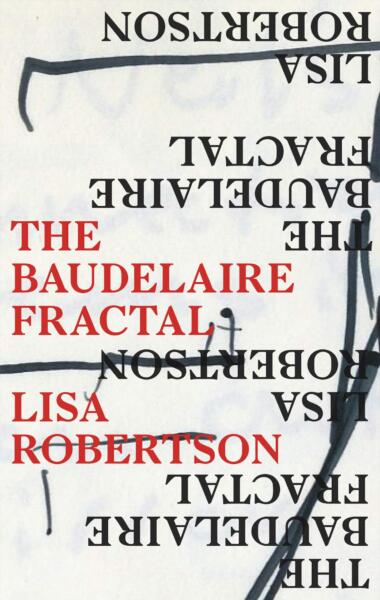
I began reading Lisa Robertson’s The Baudelaire Fractal shortly after reading Tiqqun’s Preliminary Materials for a Theory of the Young-Girl (transl. Ariana Reines). It was mid-February, precariously near the pandemic’s descent into our daily lives, and I had just returned to Notre Dame to give a reading from my newest manuscript. In my work, Jetsun Mila, I enter a trance to experience my girlhood. The trance comes from listening to Éliane Radigue’s Jetsun Mila, a sonic biography of the monk-cum-murderer Jetsun Milarepa. I still am not sure why Radigue’s work affects a kind of feverish introspection from me, why the drone-sound of a monk brings me towards girlhood specifically. Upon finishing my reading, though, I was asked if I’d read Tiqqun’s Theory of the Young-Girl. I hadn’t yet. So, the early days of my social distancing grew hyper-focused on girlhood—in both Tiqqun and Lisa Robertson’s work. Both of these books left searing impressions upon me—with questions of influence, identity and transformation.
The Baudelaire Fractal is narrated by an ambiguous, capacious “I.” Its protagonist, Hazel Brown, wakes up to find she has written the entire works of Charles Baudelaire. While this conceit seems relatively self-contained, Robertson instills in Hazel’s character—and in the novel itself—an openness, a slippery subjectivity. At times, I wonder if the “I” speaking is actually the author wearing Hazel’s mask. In an interview between Lisa Robertson and Allison Grimaldi Donahue for BOMB, Donahue asks a similar question: “I’m curious about the “I” of Hazel, how it is formed but also the very notion of naming in this novel, of the subjectivity of a number of characters. It seems like subjectivity is in process, ongoing.”
Robertson replies:
Each of us is part of a network of agreement and transmission of names. Part of the inner experience of subjectivity has to do with the tension of both accepting and querying what we’re called, whether we’re speaking of proper names or whether we’re speaking of categories that are gendered or racialized or attached to national or collective identities. There’s a tension between subjectivity and identity that is at the core of how I understand the texture of personhood.
My favorite moments in The Baudelaire Fractal reside in manifesto-like assuredness, where Robertson’s “I” explores the idea of the reading girl—where the already porous “I” reaches beyond itself. These moments give Hazel texture, a reference point both of her (once a girl) and beyond her (any girl). The reading girl could refer to Hazel’s youth, her movement towards being a writer. Whoever she is, the reading girl is radical. Robertson writes: “The reading girl, the soft action of her fingers in the text, will become philosophy, will become poetry, in a passive but total infiltration.”
Still, girlhood is not without its vulnerabilities. Robertson adds, through The Baudelaire Fractal’s ever-reaching “I”: “When I recognize afresh the courage it takes for any girl not to disappear to herself, I am still shocked.”
The forces that compel a girl to “disappear to herself” activate Tiqqun’s critique of the Young-Girl.

In Tiqqun’s Preliminary Materials for a Theory of the Young-Girl, I see a tireless pursuit of self-objectification, a kind of limbo where the self consents to stasis, never able or wanting to become, only wanting to be seen. The Young-Girl isn’t strictly female—anyone can become her. The Young-Girl is compelled to consume in perpetuation of her “youthitude” and “feminitude.” These neologisms, representative of “the idealization of youth and femininity by the apparatuses of consumer capitalism,” signify the illusory timescale of the Young-Girl. The Young-Girl is impermeable, two-dimensional, “the living and continual introjection of all repression.” Processes ranging from Botox to shaving to eating disorders contribute to the image of the Young-Girl: always desirable, always ready to be consumed through sight or sex. The Young-Girl is solely charged by a totalizing control of self-image—where self-image is, in fact, constitutive of self. As Adam Morris notes in “Drone Warfare: Tiqqun, the Young-Girl, and the Imperialism of the Trivial,” the Young-Girl is a formatted personality that represents “surrender to the youth-obsessed misogynist consumerism.”
I see Robertson’s reading girl as the antithesis of Tiqqun’s Young-Girl. The reading girl is out of control—she doesn’t seek to control herself. The reading girl is affected by the very act of reading. The reading girl doesn’t seek stasis, she seeks movement. In her BOMB interview, Robertson notes: “If I think of my childhood and adolescent reading experiences, which were very personal and private, reading was deeply emotional. I spent so much time crying when I was reading as a child, and puzzling over mortal things.” The reading girl is always transforming, always transformed. The reading girl infiltrates the Young-Girl from this site of transformation.
Roberston asks:
“How does a girl become what she is—with no knowledge, but all of her own visceral autonomy?”
In her own kind of infiltration, Robertson is committed to moving the figure of the reading girl into literary and popular culture. In the same interview, she also says: “I still think girls’ intellectual experience is not represented and honored and respected in literary or popular culture, not in the way that it absolutely needs to be.” Using her own intellectual experience as material, Robertson recuperates old diary entries from her twenties into The Baudelaire Fractal, activating the voice of a past self—and charging Hazel’s character with an autobiographical double. Here, Robertson’s protagonist gains texture in her simultaneous representation of fiction and nonfiction.
As Hannah V Warren writes in her blog post on Valerie Hsiung: “in transformational rhetoric, we find […] shifting bodies.”
AM Ringwalt is a writer and musician. Her words appear or are forthcoming in Peripheries, the Washington Square Review and the Bennington Review. Called “unsettling” by NPR and “haunted” by The Wire, she has performed her music at the Watermill Center and the New Yorker Festival. @amringwalt